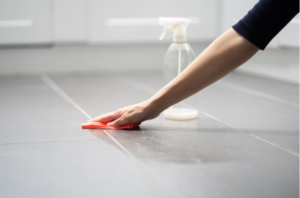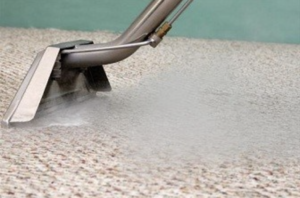
How to Clean a Bathroom: A Step-by-Step Guide for Sparkling Results
How to Clean a Bathroom: A Step-by-Step Guide for Sparkling Results A clean bathroom is not only essential for hygiene, but it also creates a pleasant and inviting space in your home. Cleaning your bathroom may seem like a daunting task, but with the right approach, cleaning can be quick, efficient, and even satisfying. Whether you’re tackling your sink, toilet, shower, or bathtub, this comprehensive guide will walk you through the best methods and cleaning products to use to achieve a sparkling bathroom. Why a Clean Bathroom Matters Bathrooms are high-traffic areas and often become breeding grounds for germs, mould, and mildew. Regular cleaning can help eliminate bacteria, prevent the buildup of soap scum and limescale, and maintain the overall appearance of your bathroom. Plus, a fresh and clean bathroom makes for a more enjoyable experience every time you step in. What You’ll Need to Clean Your Bathroom Before we dive into the cleaning steps, it’s important to gather the right tools and cleaning products. Here’s a list of products you should consider buying: All-purpose cleaner Disinfectant spray or wipes Glass cleaner Toilet bowl cleaner Baking soda Vinegar Microfiber cloths Scrub brushes (soft and hard-bristled) Sponges Rubber gloves A mop and bucket (if needed) A squeegee for the shower glass Step 1: Declutter and Prepare Your Bathroom Before you begin cleaning, remove any items from countertops, shelves, and the floor. This includes toiletries, towels, rugs, and bath products. You want to start with a clear space so you can reach every surface with ease. If you have bath mats or towels that need washing, set them aside. Step 2: Clean the Sink The bathroom sink is where a lot of everyday grime, toothpaste, soap scum, and water spots accumulate. Here’s how to clean it effectively: Remove Items: Take all toiletries, soap dispensers, and toothbrush holders off the counter. Apply Cleaner: Spray an all-purpose cleaner or a mild bathroom cleaner on the sink, faucet, and surrounding countertop. A cleaner with natural ingredients, such as one that includes citric acid or vinegar, can effectively break down soap scum without being harsh on surfaces. Clean Faucets: Use a microfiber cloth or sponge to wipe down the faucet handles, spout, and base. Be sure to scrub any mineral buildup, which can often appear around the faucet where water has dried. Scrub the Sink: For stubborn stains, sprinkle some baking soda onto the surface of the sink. Use a non-abrasive scrub brush to scrub the sink in circular motions, paying extra attention to any grime around the drain and faucet. You can also use a toilet cleaner such as Harpic (more on that later!). Rinse and Dry: Rinse the sink thoroughly to remove all cleaning products and grime. Use a dry cloth to wipe away water spots and keep the sink looking shiny. Step 3: Clean the Toilet Toilets are often the focal point of bathroom cleaning, and for good reason. It’s essential to keep them spotless and disinfected to prevent germs and odours from spreading. Here’s how to do it: Apply Toilet Bowl Cleaner: Pour a generous amount of toilet bowl cleaner around the rim of the toilet bowl. Let it sit for 10-15 minutes to disinfect and dissolve any buildup. Scrub the Toilet Bowl: After the cleaner has had time to sit, use a toilet brush to scrub the inside of the bowl, including under the rim. Make sure to scrub the entire bowl to remove stains and mineral deposits. Disinfect the Exterior: Spray the exterior of the toilet, including the tank, lid, seat, and base, with a disinfectant cleaner. Wipe down these areas using a microfiber cloth. Don’t forget to clean the flush handle—this is a high-touch area that can harbour germs. Flush and Rinse: After scrubbing the toilet bowl, flush to rinse away the cleaner. Wipe down the seat and lid with a clean, dry cloth. Step 4: Clean the Shower The shower is one of the most challenging areas to clean due to soap scum, mold, and mildew buildup. However, with the right products and technique, you can keep it spotless. Here’s how to do it: Remove Items: Take out any shampoo bottles, soap, or other products from the shower. Apply a Shower Cleaner: Use a bathroom cleaner specifically designed for soap scum and mildew, or mix equal parts of vinegar and water in a spray bottle. Spray the entire shower, including walls, doors, and the shower floor. Let the cleaner sit for 10-15 minutes to break down grime and soap residue. Scrub the Tiles and Grout: Using a soft scrub brush or sponge, scrub the shower tiles and grout lines to remove buildup. For stubborn stains, you can make a paste using baking soda and water. Apply it to the grout lines and scrub it gently with a brush. Clean the Shower Doors: If you have glass shower doors, spray them with a glass cleaner or a vinegar-water solution to remove water spots and soap scum. Use a squeegee to wipe down the glass, ensuring a streak-free finish. Rinse and Dry: After scrubbing, rinse the entire shower area thoroughly with warm water. Wipe down all surfaces with a clean, dry cloth to remove excess water and prevent new spots from forming. Step 5: Clean the Bathtub Cleaning the bathtub is similar to cleaning the shower, but since bathtubs often accumulate soap scum and stains, you may need to use a stronger cleaner. Here’s how to clean your bathtub effectively: Apply Cleaner: Apply a bathroom cleaner to the bathtub surface, focusing on areas with soap scum buildup or stains. You can use a specific tub cleaner or a mixture of equal parts vinegar and water. Scrub: Use a sponge or soft scrub brush to clean the tub’s surface. Pay attention to the drain area and faucet to ensure no grime is left behind. Clean the Overflow and Jets: If your bathtub has jets or an overflow drain, be sure to clean those areas as well. Use a toothbrush










